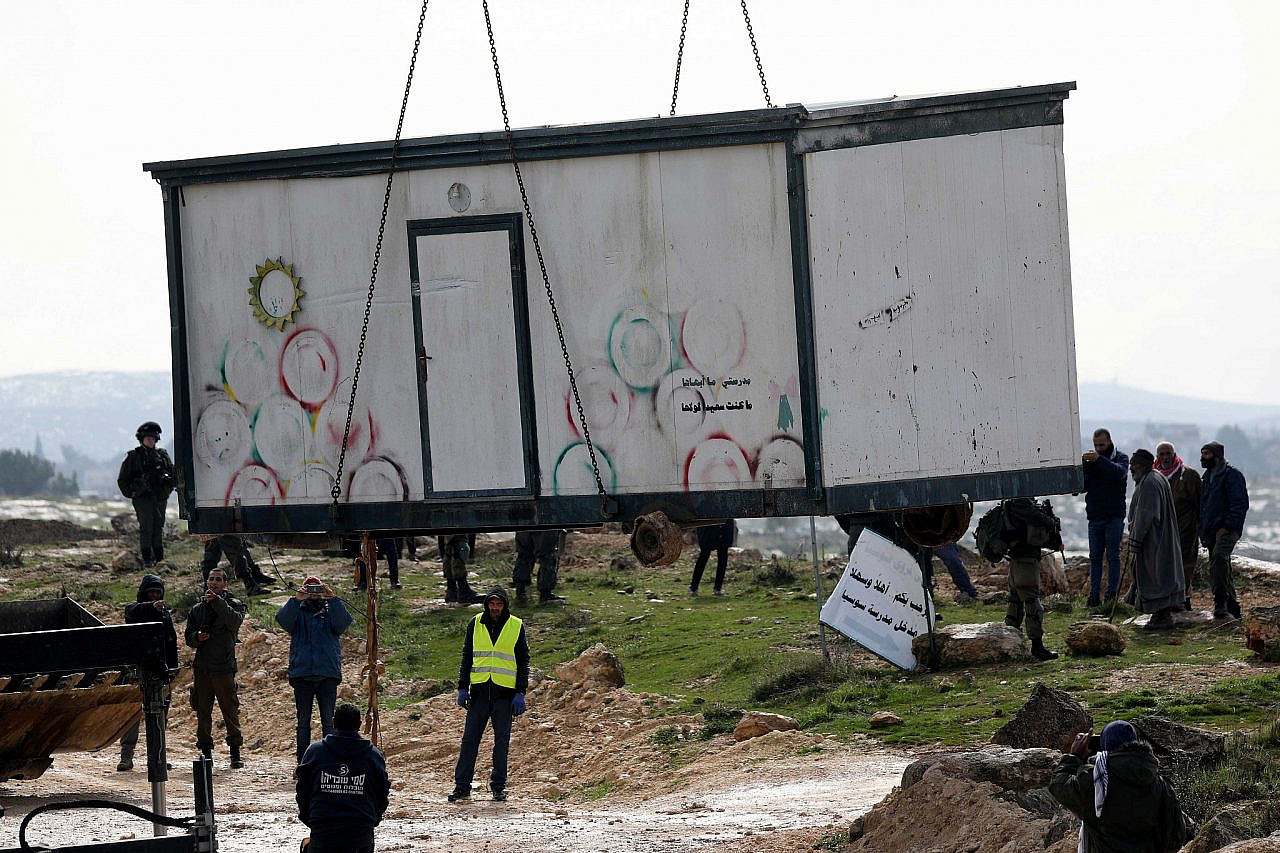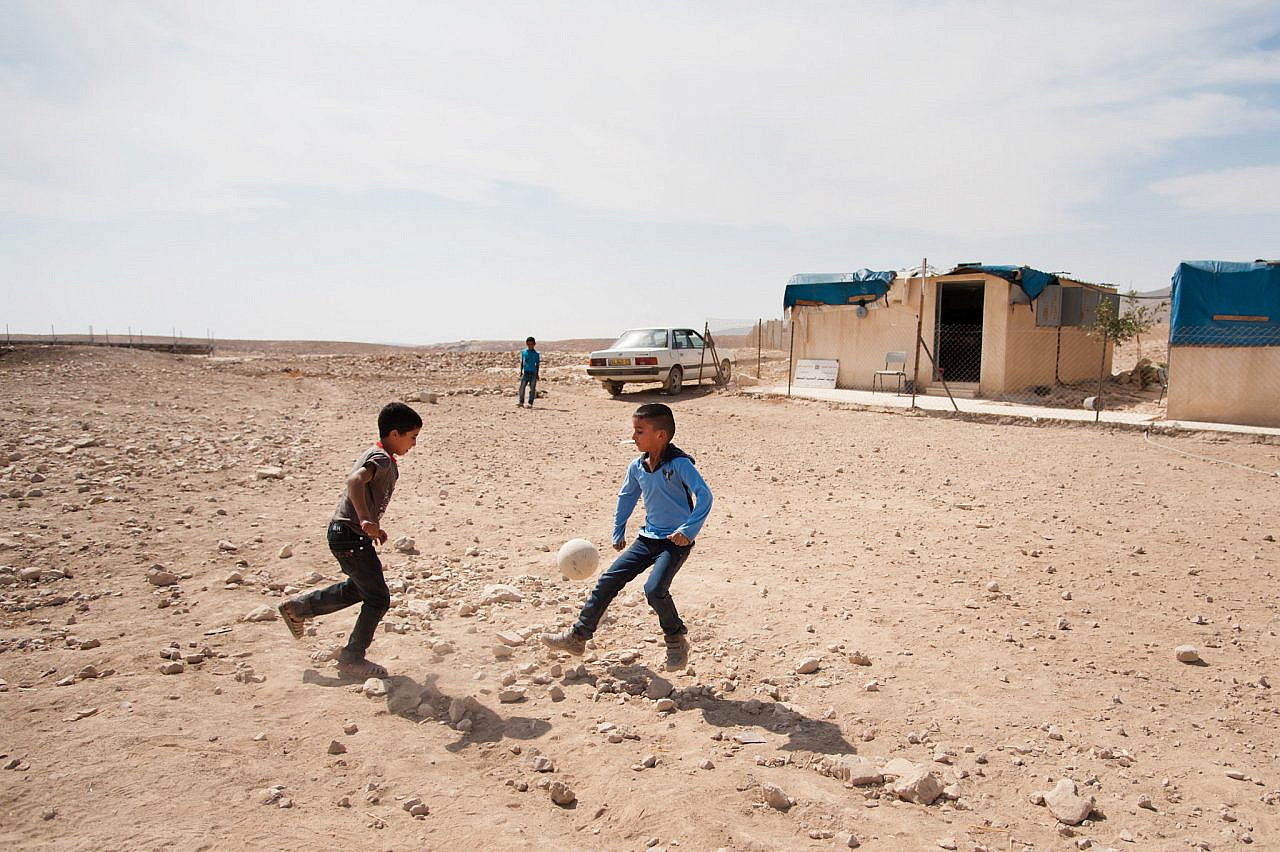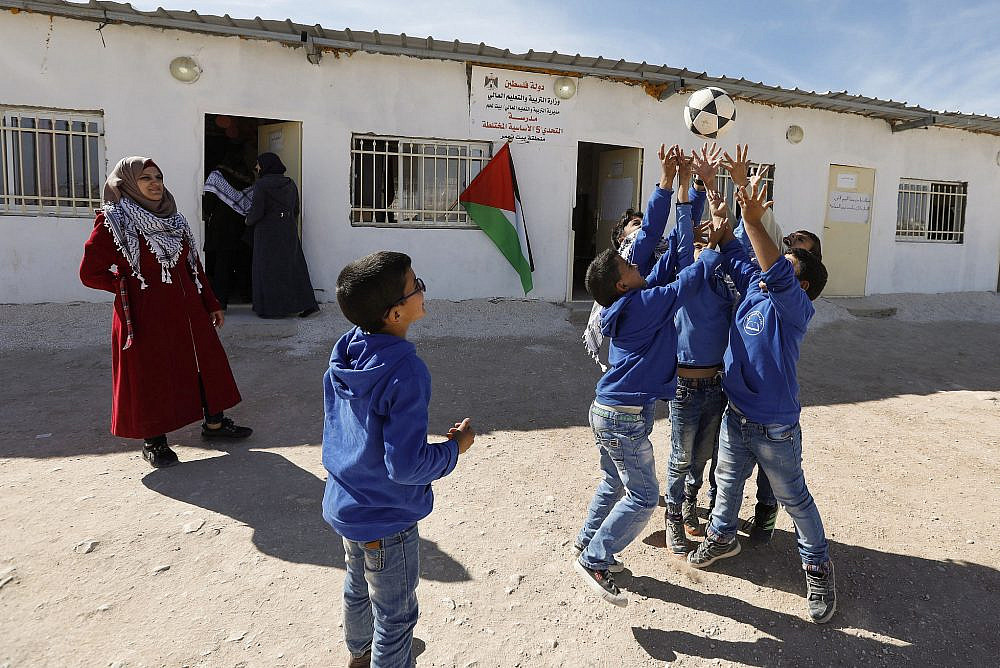This article was published in partnership with Local Call.
For many Palestinians in the occupied West Bank, education is not a right but a privilege that Israel can take away at will. This is especially true for those of us who live in Area C, the 60 percent of the West Bank that is under full Israeli military and administrative control; since 2016, Israel has demolished 10 schools built in Palestinian villages in Area C.
Those schools served communities in three areas where Palestinian residents have faced sustained Israeli pressure to leave: the Jordan Valley, Masafer Yatta (where I live), and the area between Jerusalem and the Dead Sea. Area C is home to 180 Palestinian villages that Israel does not recognize, and whose residents are barred from building any kind of structures on their land.
Ein Samiya is one such small village located next to Ramallah, and is home to 300 Palestinians. Israel has never recognized the hamlet, and it remains disconnected from water and electricity. But last month, with the help of the Palestinian Authority (PA), Ein Samiya’s residents built a school in the vicinity. The school is one of 20 that have been built recently for the Palestinian communities of Area C, as part of an initiative led jointly by the Palestinian Ministry of Education and the PA’s Committee Against the Wall and Settlements.
“We are setting up schools in Area C, in villages that have a critical need for educational institutions,” says Younas Arar, coordinator of external relations at the Committee Against the Wall and Settlements and one of the leaders of the project which has been named “Schools for Sumud” [the Arabic word for “steadfastness”]. “Schools help residents survive on their land and not leave despite the tremendous repression that the occupation places on them.”
According to Arar, the educational project, which was launched in 2016, significantly reduces the student dropout rate — especially that of female students, a widespread phenomenon that characterizes villages in Area C. “In some villages, girls have to walk many miles to get to school,” he said. Building schools in their villages “saves them time and effort, and allows them to invest in their studies.”
Since the project began, dozens of schools have been established in unrecognized Palestinian villages across the West Bank. Most of them have received demolition orders from the Civil Administration. Some of the schools have been demolished, while others are still standing after the communities appealed the orders.
Abir al-Khatib, an activist with Schools for Sumud, has set up four schools with her own hands in recent years. “The first time I built a school,” she said, “it was in the village of Jubbet ad-Dib, near Bethlehem.” Jubbet ad-Dib was established in 1929, and today is home to around 160 residents. Many have left over the years due to Israel’s refusal to allow construction in the village and to connect it to the electricity grid and water infrastructure.
“Mothers from the village told me how much they want their children to have a school. It touched me, perhaps because I am also a mother. So I came to build for them. People were surprised by my presence as a woman dealing with concrete — the only women among men. But despite the surprised looks, I stayed there and we built the school. I do this because I believe in the role that Palestinian women need to play in the struggle for freedom.”

Last month, Abir helped build the school in Ein Samia. According to Muhammad al-Qa’abna, a resident of the village, the 300 residents have lived without infrastructure for 40 years. They settled there after the Israeli army expelled them from other parts of the West Bank.
“The residents there are surrounded by the settlement [Kochav Hashahar] and outposts, which are trying to expel them by force,” said Abir. “In the past, 38 families lived there, but today, due to pressure by the settlers with the help of the army, only 19 families remain. They need a school, and we had to help them — for the sake of their lives and the lives of their children.”
Like Ein Samia, the village of Zanuta in the southern West Bank is also unrecognized. In April 2018, the Schools for Sumud initiative built a school there as well, which was demolished by the Israeli authorities two weeks after its construction was completed.
“Our children suffered greatly [from the demolition], they walked long distances, even in cold or extreme heat, to the nearby town of Dahariya. Some had to immigrate to the city to live near the school,” said Adel al-Tal, who heads Zanuta’s local council. “Since then, we have built another school — which stands in the village to this day — but have already been served three demolition orders.”
It takes a village
I know first-hand what it takes to build a school against Israel’s will. My school was built thanks to my mother. When I was born, A-Tuwani, my home village in the South Hebron Hills, did not have a school. There was not a single school that served the 20 villages of Masafer Yatta, the name of the area in which A-Tuwani is located, made up of mostly farmers and shepherds. The army prevents us from building schools — or any other structure — as a means of expelling us.
My parents were never able to go to school. “In order to study, children needed to walk many kilometers to reach the city of Yatta,” my mother, Kifah, tells me. The journey, which included crossing a highway, was dangerous, and frightened many parents away from sending their children to school. “The girls mostly dropped out,” my mother says. This struggle plagues many West Bank schools until today.
In 1998, when I was two years old, the residents of A-Tuwani decided things needed to change. “We built three classrooms and asked the Palestinian Authority for a budget, and we got it,” my mother says. “The men bought building materials and construction began. But as they worked, the army raided the village and threatened that if they continued, the men would all be arrested and their materials confiscated.”
A few days later, as my father was building the classrooms, a representative from the Civil Administration — the arm of Israel’s military that governs the Palestinians in the occupied West Bank — arrived in the village to hand out a demolition order for the school. “I had an idea,” my mother tells me, “that we, the women, would replace the men. Throughout the day, we did simple construction work and protected the building materials. At night, we would stand at the top of the hill and warn the men when the army arrived.”
The school was eventually built, and I studied there from first until 12th grade. The success of my parents’ struggle turned me into an activist and pushed me to continue their path: to struggle for education, health, construction permits, and independence. For the basic rights that we do not have under military occupation.

Next to A-Tuwani, the village of Halat a-Daba saw its school demolished in July 2018. The children there suffer particularly because this year the army destroyed and blocked the roads that connect the village to the other hamlets in the area, making it impossible for buses to pick up the students and drive them to the nearby school.
In 2019, an elementary school was built in the village, and demolition orders were quick to follow. However, the school only goes up to fifth grade; for this reason, every morning for the past two years, I have been collecting the older students of the village and driving them by jeep to the high school in A-Tuwani.
There are eight children in all, but I do not have enough seats in the car for them, which means they are forced to sit on top of each other, two per seat. The roads in Halat a-Daba are full of large rocks and potholes left by soldiers with D9 bulldozers this year. At least twice a week, I have a flat tire and the kids are late for school. The principal reprimands the children: “You have to arrive at a quarter to eight,” he tells them, “otherwise you are not allowed to enter the classroom.”
The parents of the students in Halat a-Daba recently demanded that the Palestinian Ministry of Education invest in building more classrooms in the village. But since any new construction could be destroyed by the Israeli army at any time, the PA is in no hurry to do so.
A version of this article was first published in Hebrew on Local Call. Read it here.


